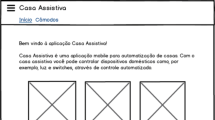Abstract
Incorporating multimodality in a computing system makes computing more accessible to a wide range of users, including those with impairments. This work presents a paradigm of a multimodal multimedia computing system to make informatics accessible to visually-impaired users. The system’s infrastructure determines the suitable applications to be used. The user’s context and user data type are considered in determining the types of applications, media and modalities that are appropriate to use. The system design is pervasive, fault-tolerant and capable of self-adaptation under varying conditions (e.g. missing or defective components). It uses machine learning so that the system would behave in a pre-defined manner given a pre-conceived scenario. Incremental learning is adapted for added machine knowledge acquisition. A simulation of system’s behaviour, using a test case scenario, is presented in this paper. This work is our original contribution to an ongoing research to make informatics more accessible to handicapped users.
This work has been made possible the funding awarded by the Natural Sciences and Engineering Research Council (NSERC) of Canada.
Preview
Unable to display preview. Download preview PDF.
Similar content being viewed by others
References
Djenidi, H., et al.: Generic Multimedia Multimodal Agents Paradigms and their Dynamic Reconfiguration at the Architectural Level. EURASIP Journal on Applied Signal Processing 2004(11) (September 2004)
McCullough, M.: Digital Ground: Architecture, Pervasive Computing, and Environmental Knowing. MIT Press, Cambridge (2004)
Mitchell, T.M.: Machine Learning. McGraw-Hill, USA (1997)
Giraud-Carrier, C.: A Note on the Utility of Incremental Learning. AI Communications 13(4), 215–223 (2000)
Ross, D.A.: Cyber Crumbs for Successful Aging with Vision Loss. IEEE Pervasive Computing 3(2), 30–35 (2004)
Royal Natl Institute of the Blind, Final Report of the TIDE, UK (1995), website: http://www.rnib.org.uk
Meijer, P.: The vOICe: Vision Technology for the Totally Blind, (2005), website: http://www.seeingwithsound.com/voice.htm
Archambault, D.: BrailleSurf: An HTML Browser for Visually Handicapped People. In: CSUN Conf., Los Angeles, USA (1999)
King, A., et al.: WebbIE, A Web Browser for Visually Impaired People. In: 2nd CWUAAT Workshop, Cambridge, UK (2004)
Moço, V., Archambault, D.: Automatic Conversions of Mathematical Braille: A Survey of Main Difficulties in Different Languages. In: ICCHP Conference, Paris, France (2004)
Ferreira, H., Freitas, D.: Enhancing the Accessibility of Mathematics for Blind People: the AudioMath Project. In: ICCHP Conference, Paris, France (2004)
Wooldridge, M.: An Introduction to Multi-agent Systems. Wiley, Chichester (2001)
Bourbakis, N.G., et al.: An Intelligent Assistant for Navigation of Visually Impaired People. In: 2nd IEEE Intl. Symposium on Bioinformatics and Bioengineering Conference (2001)
Edwards, A.: MATHS, Mathematical Access for TecHnology and Science, UK (1997), http://www.cs.york.ac.uk/maths
Bellik, Y.: Interfaces multimodales: concepts, modèles et architectures, Ph.D. Thesis, Université d’Orsay, Paris (1995)
Antoniol, G., et al.: A Distributed Architecture for Dynamic Analyses on User-profile Data. In: 8th European Conference on Software Maintenance and Reengineering (2004)
Bougant, F., Delmond, F., Pageot-Millet, C.: The User Profile for the Virtual Home Environment. IEEE Communications Magazine 41(1), 93–98 (2003)
Okamoto, M.: Design and Application of Learning Conversational Agents. Ph.D. Thesis, Department of Social Informatics, Kyoto University (2003)
Hina, M.D., et al.: A Ubiquitous Context-sensitive Multimodal Multimedia Computing and Its Machine-Learning Assisted Reconfiguration at the Architectural Level. In: Workshop on Multimedia Information Proc. and Retrieval, 7th IEEE Intl. Symp. on Multimedia (2005)
Herbordt, W., et al.: Noise-Robust Hands-Free Speech Recognition on PDA’s Using Microphone Array Technology. Autumn Meeting of the Acous, Society of Japan (2005)
Han, T., et al.: Structure Analysis for Dynamic Software Architecture. In: 6th Intl. Conf. on Software Eng., Artificial Int., Net. and Parallel/Dist. Comp. (May 2005)
Horn, P.: Autonomic Computing: IBM’s Perspective on the State of Information Technology, IBM Research (2001)
Author information
Authors and Affiliations
Editor information
Editors and Affiliations
Rights and permissions
Copyright information
© 2006 Springer-Verlag Berlin Heidelberg
About this paper
Cite this paper
Awde, A., Hina, M.D., Tadj, C., Ramdane-Cherif, A., Bellik, Y. (2006). A Paradigm of a Pervasive Multimodal Multimedia Computing System for the Visually-Impaired Users. In: Chung, YC., Moreira, J.E. (eds) Advances in Grid and Pervasive Computing. GPC 2006. Lecture Notes in Computer Science, vol 3947. Springer, Berlin, Heidelberg. https://doi.org/10.1007/11745693_61
Download citation
DOI: https://doi.org/10.1007/11745693_61
Publisher Name: Springer, Berlin, Heidelberg
Print ISBN: 978-3-540-33809-3
Online ISBN: 978-3-540-33810-9
eBook Packages: Computer ScienceComputer Science (R0)




